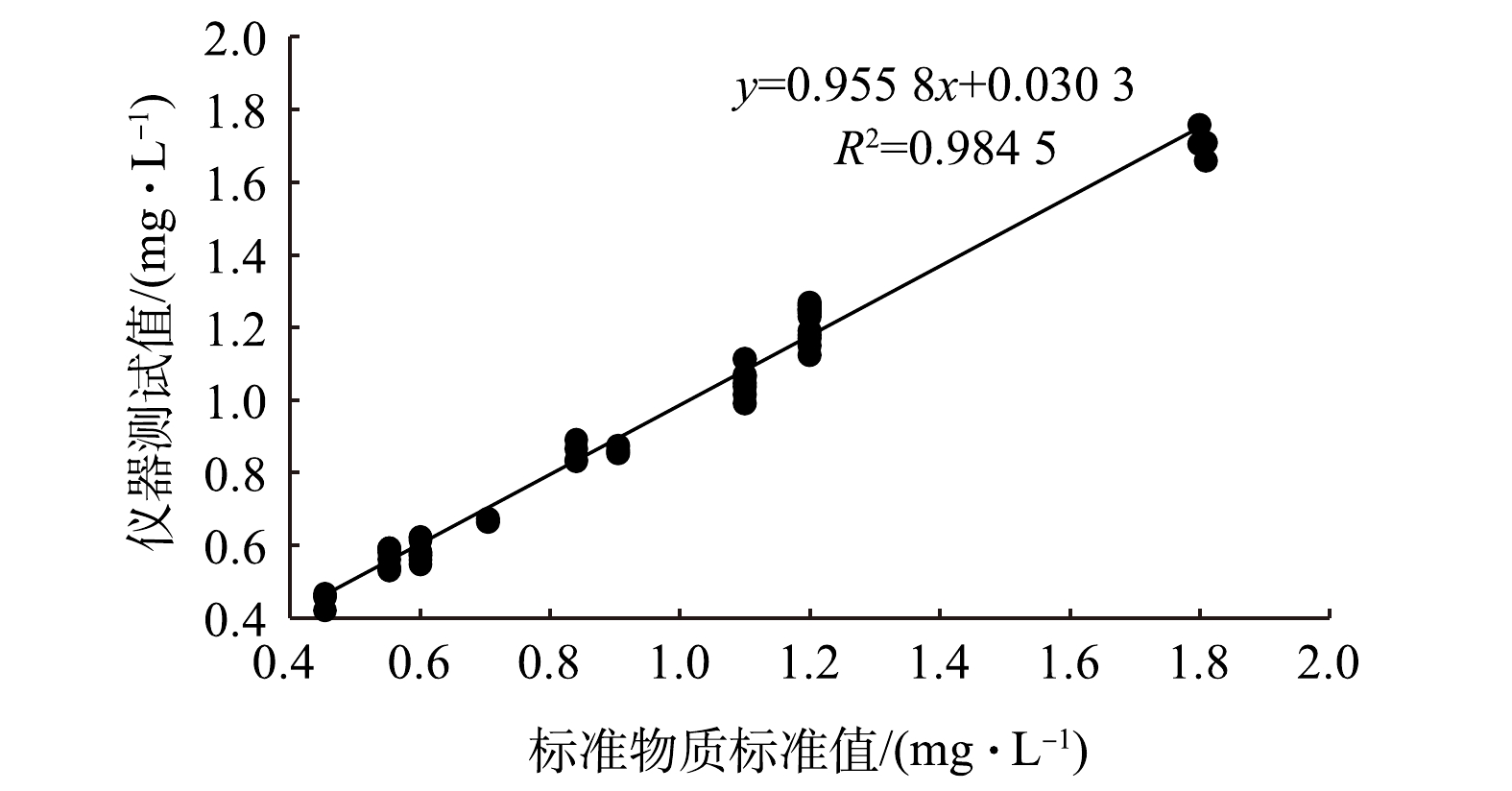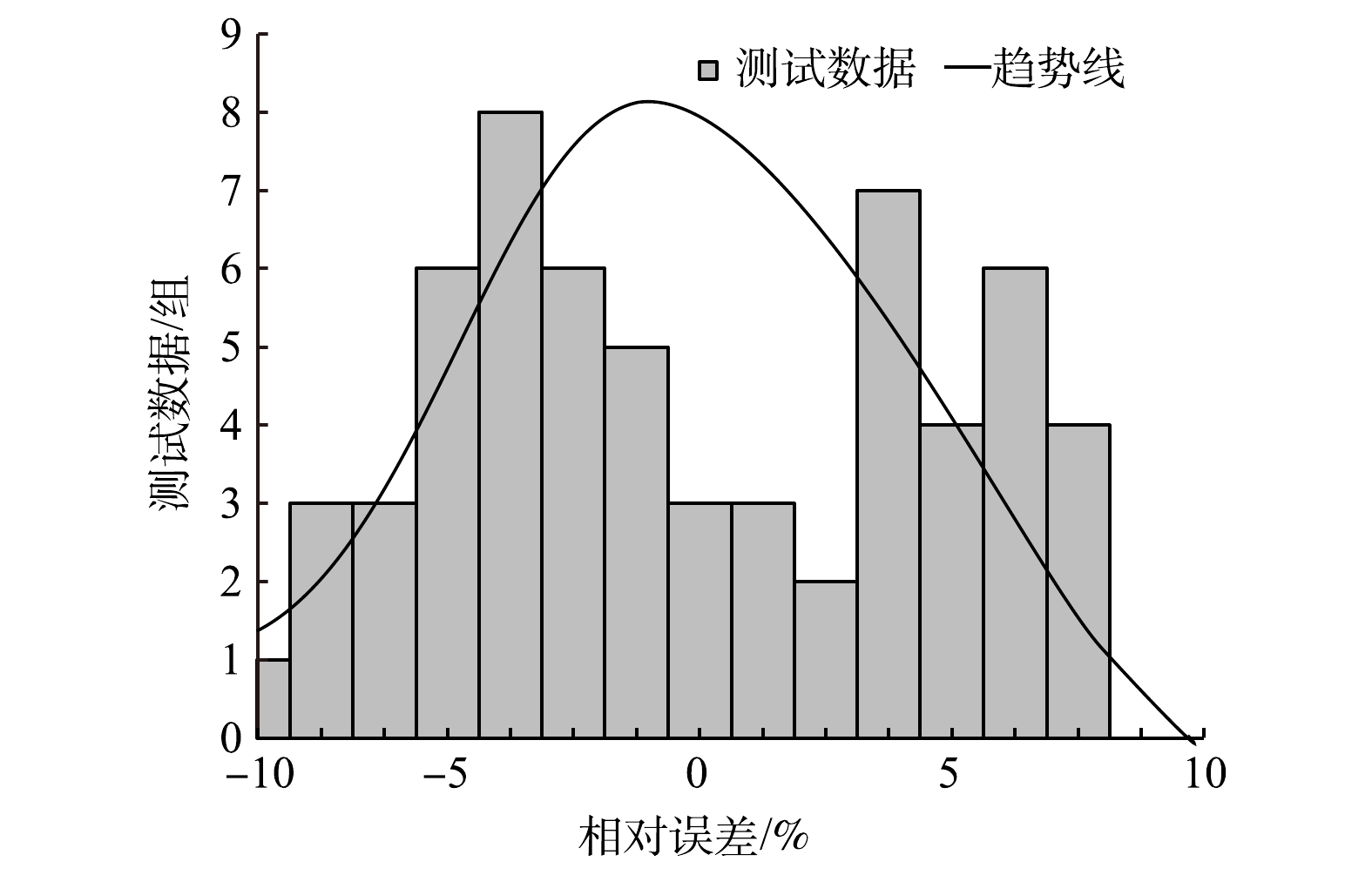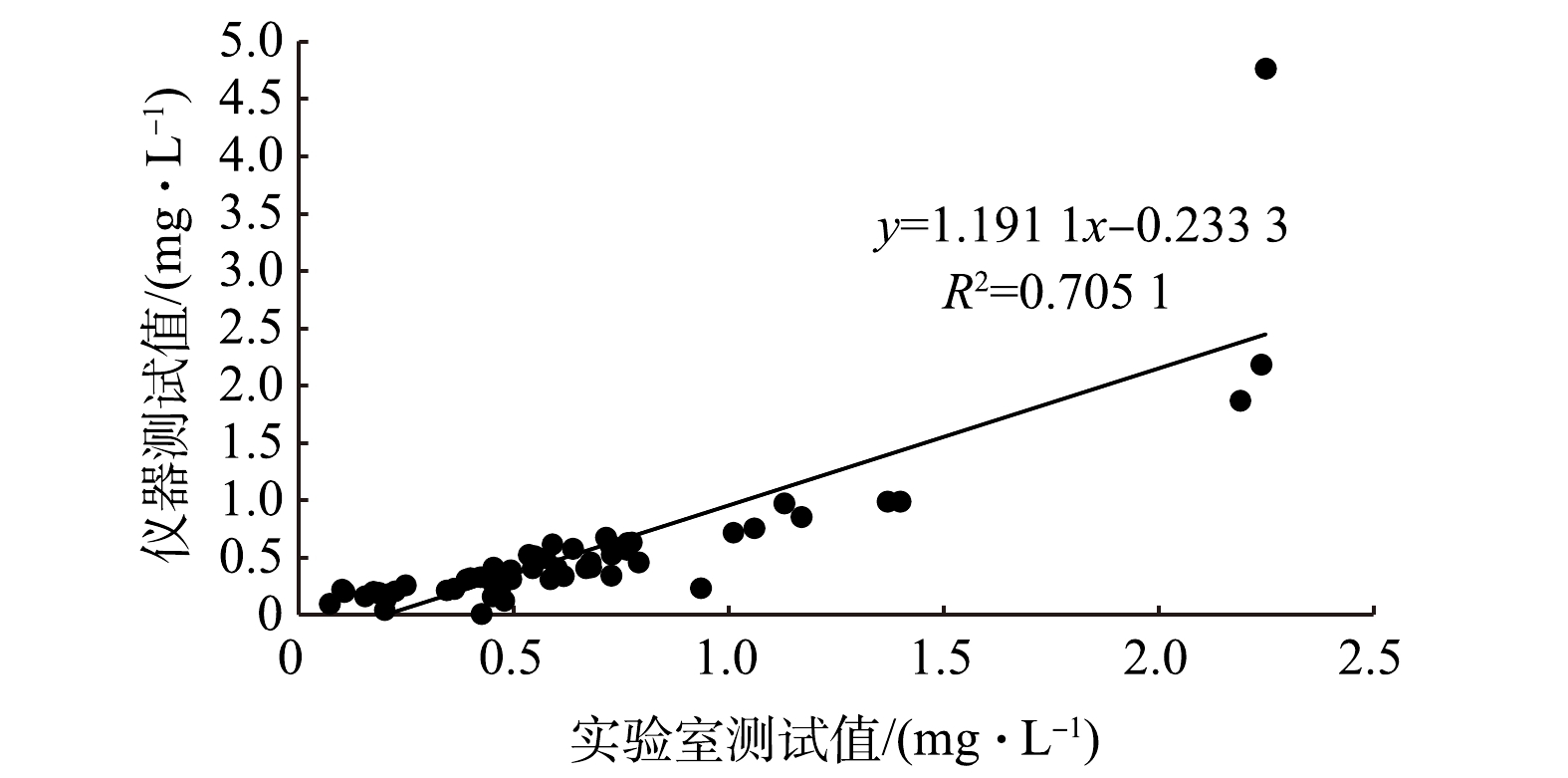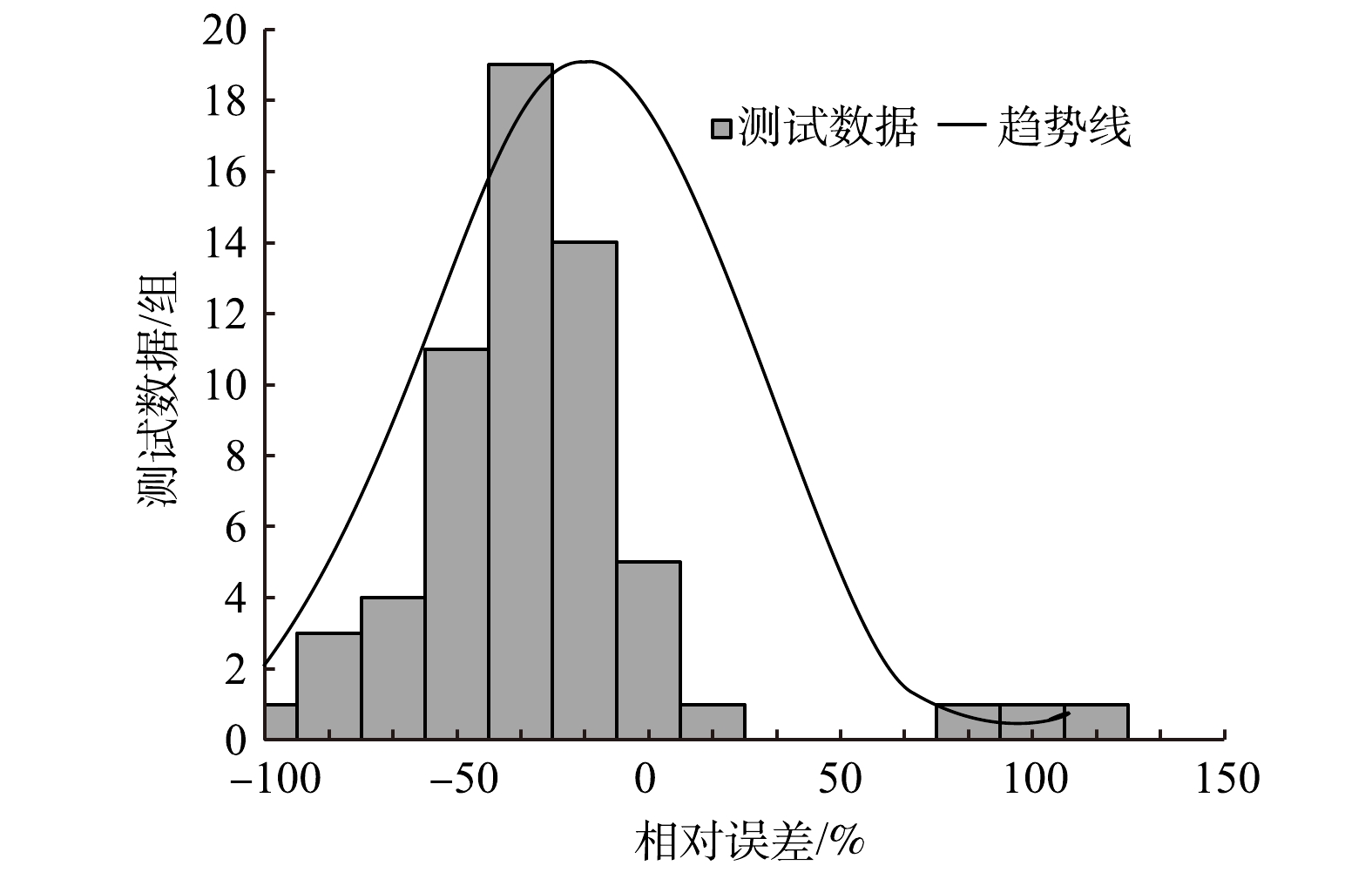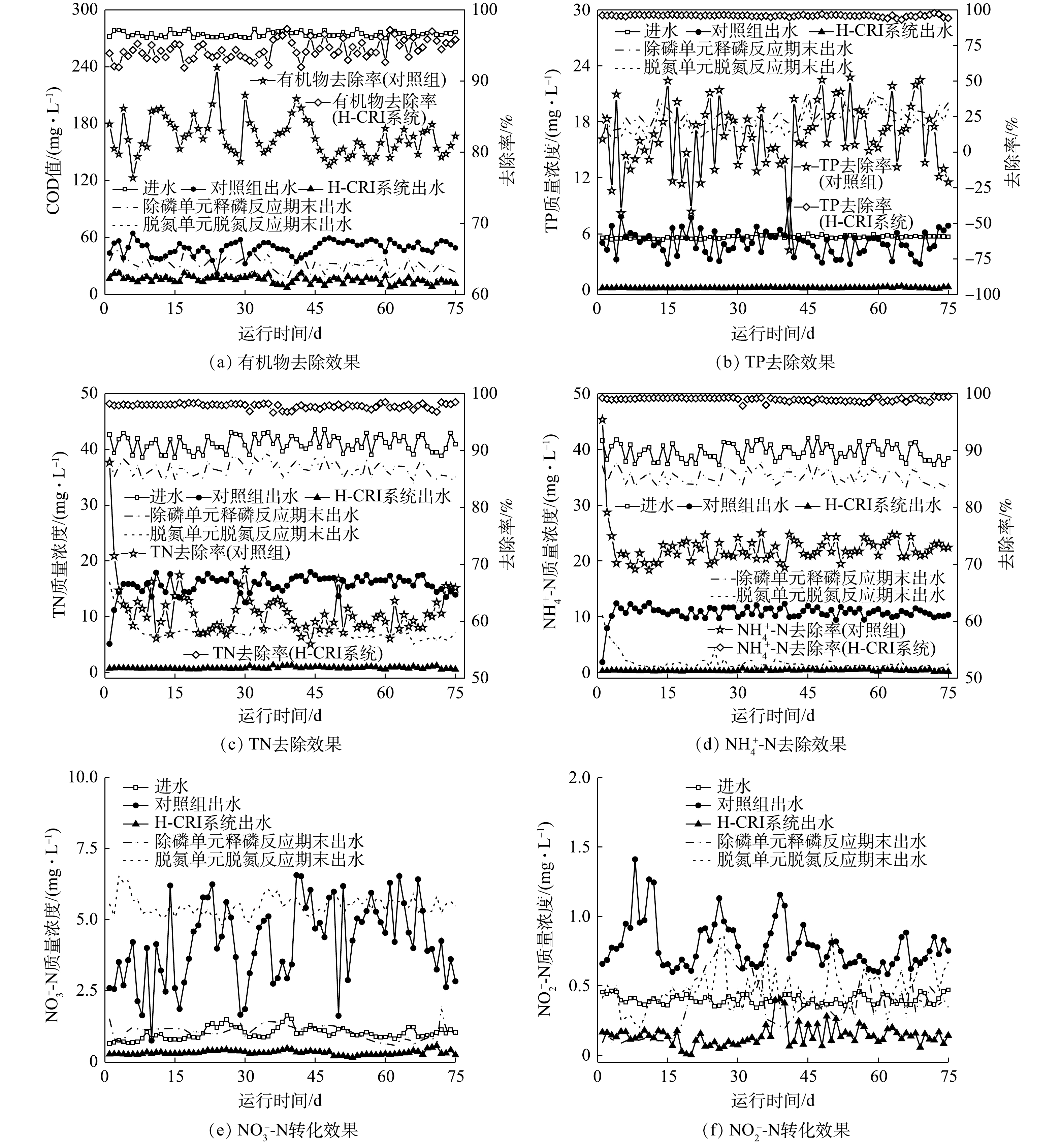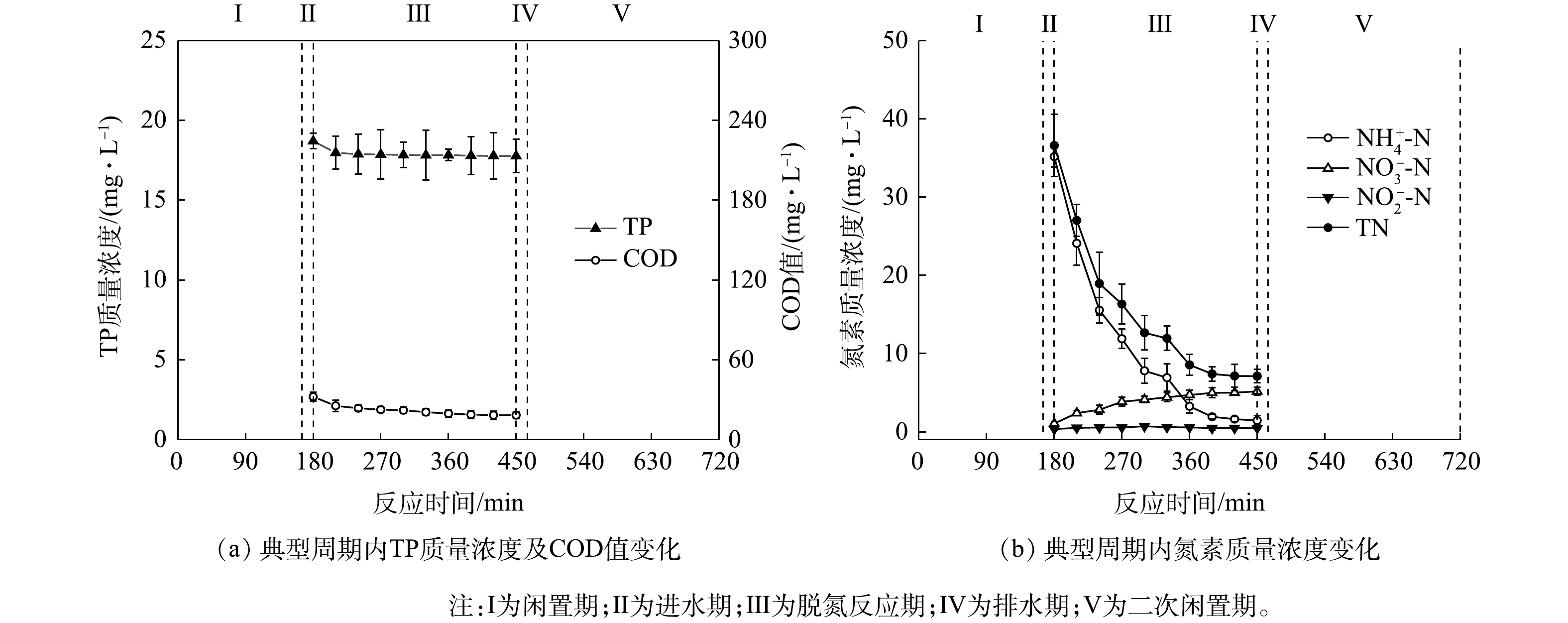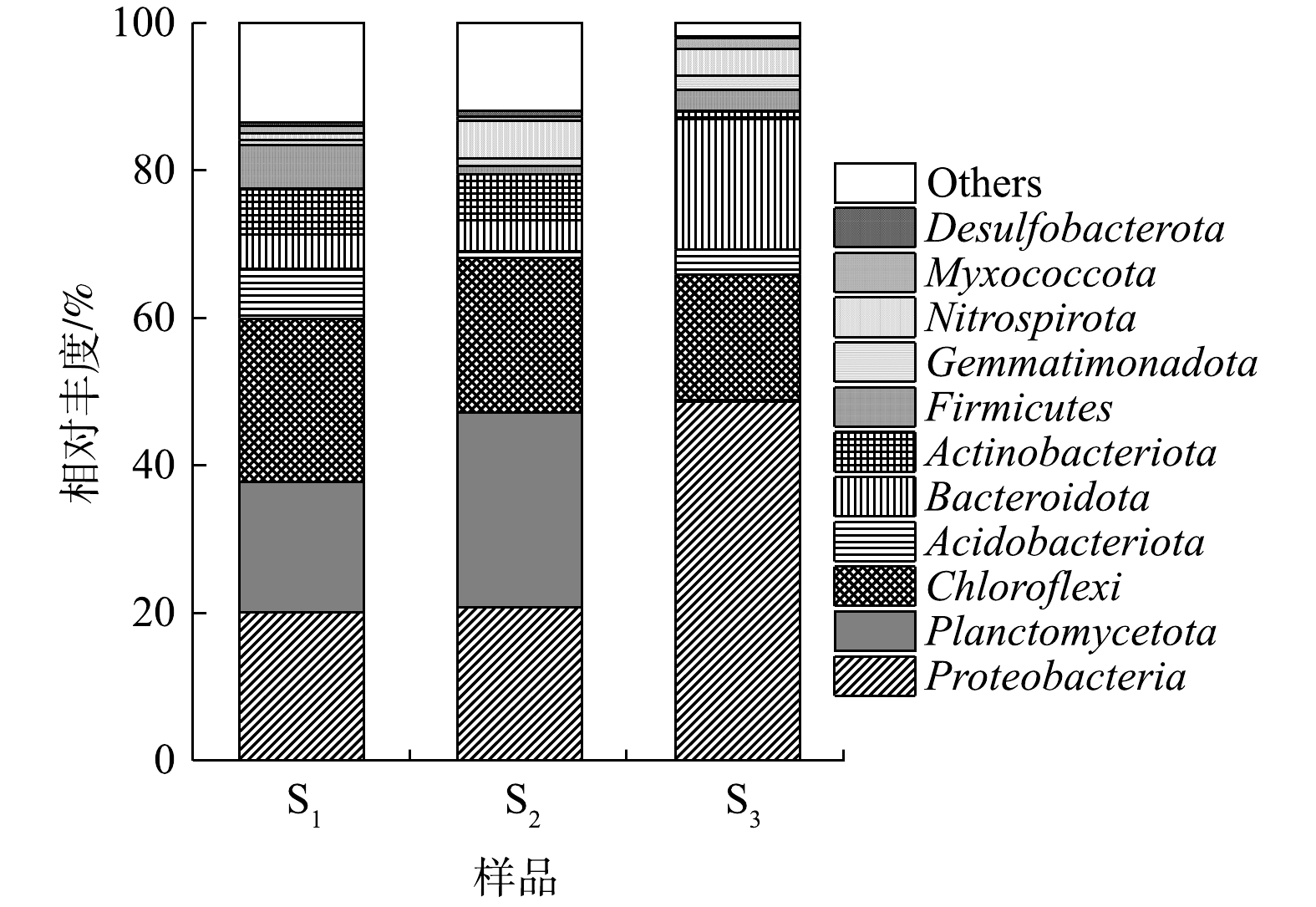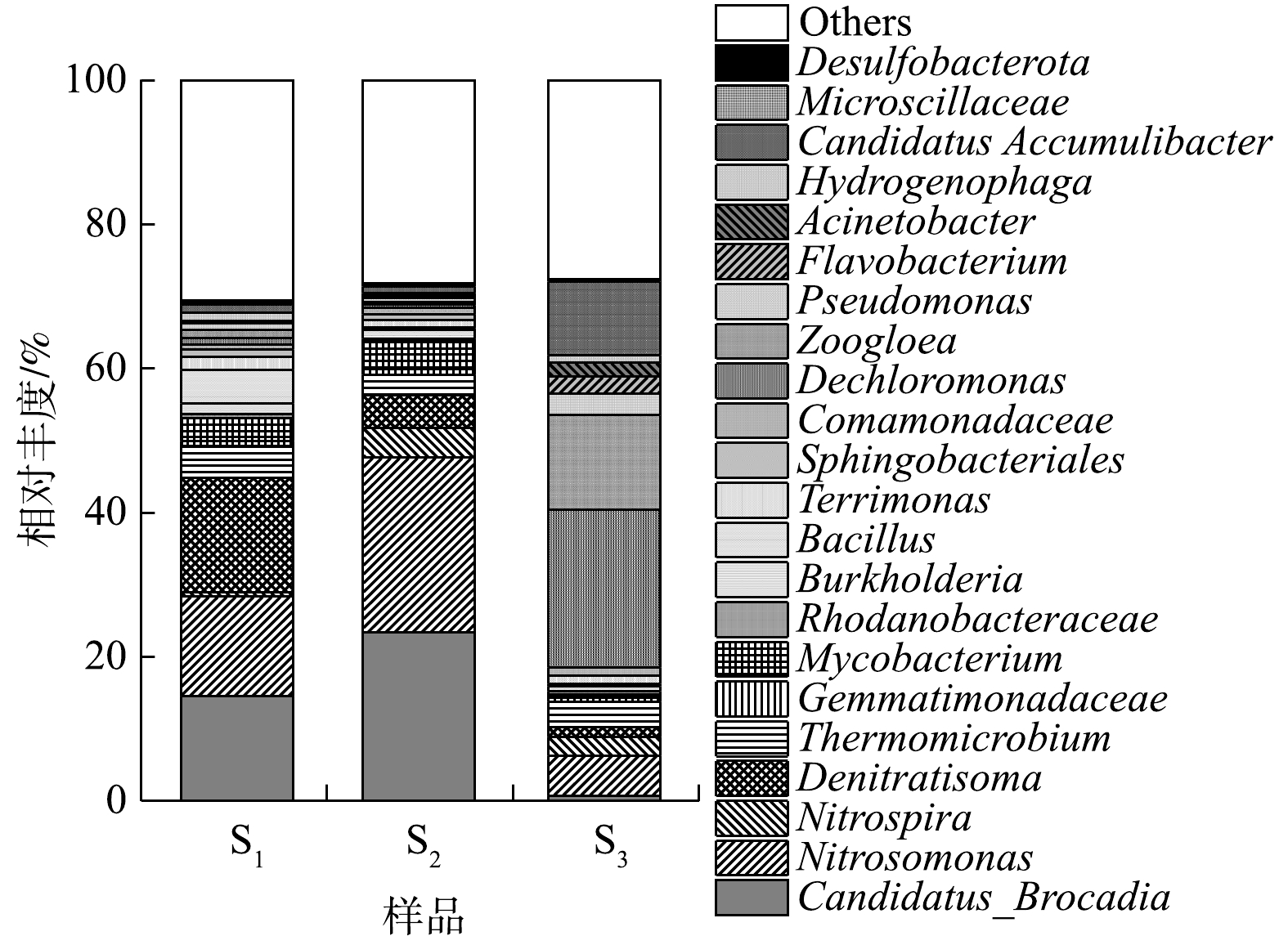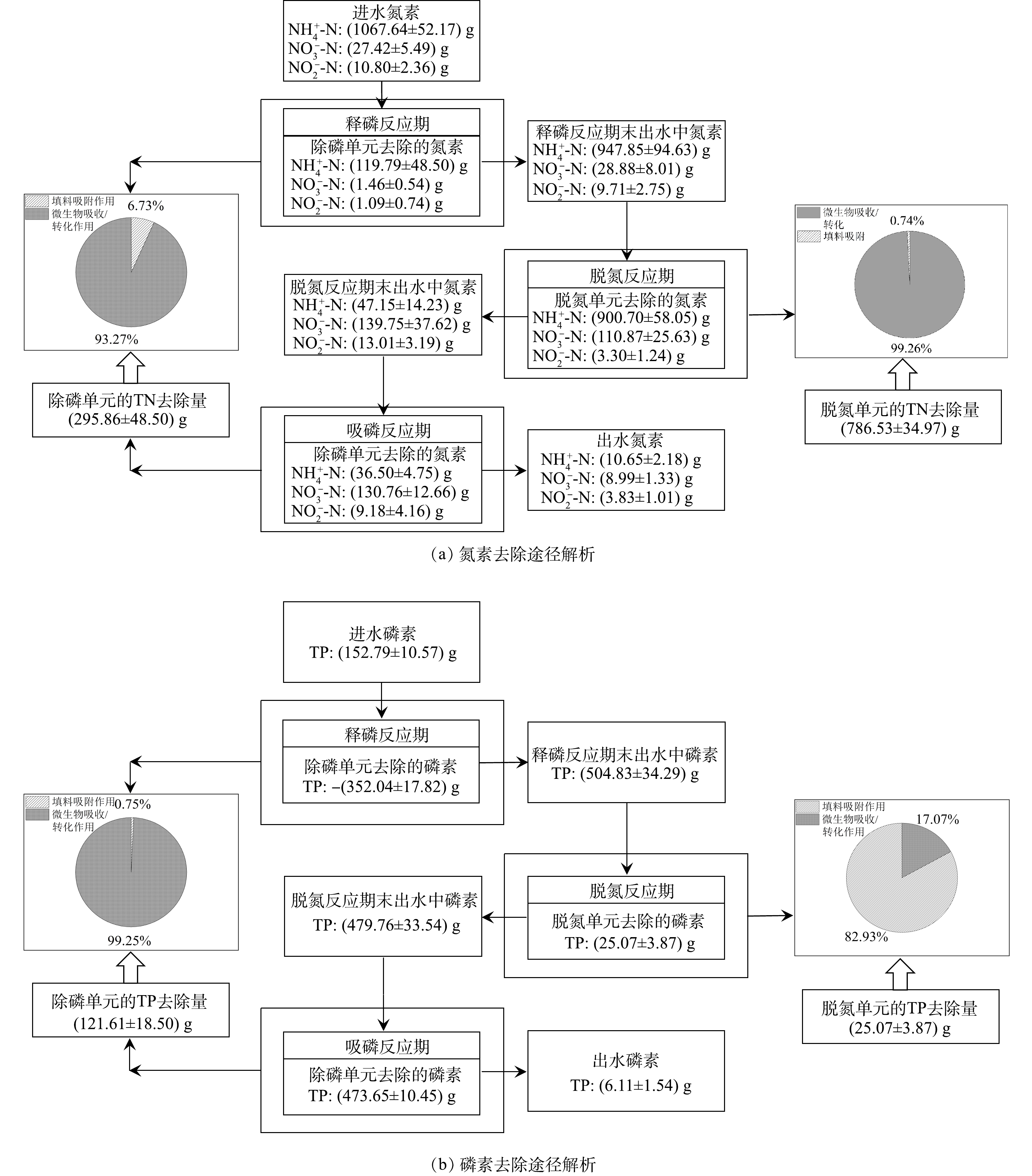-
提高人工快速渗滤(constructed rapid infiltration,CRI)系统的脱氮除磷性能是确保该工艺高效处理城镇生活污水的关键[1-2]。在诸多研究中,强化CRI系统中基于亚硝化的全程自养脱氮(completely autotrophic nitrogen removal over nitrite,CANON)作用被认为是提高该工艺脱氮效果的重要途径,此技术随之用于城镇生活污水处理[3]。截至目前,有学者相继开展了常温和低
NH+4 -N浓度下CRI系统中CANON作用的发生及强化研究,并取得了一定进展[4-5]。然而,在处理城镇生活污水时,CANON型CRI工艺仍存在不足,突出表现在以下2点:首先,由于污水中不可避免地含有一定浓度的有机物,CRI系统中的CANON作用通常与反硝化耦合,以期通过构建同步亚硝化、厌氧氨氧化(anaerobic ammonia oxidation,ANAMMOX)与反硝化(simultaneous nitrification,ANAMMOX and denitrification,SNAD)耦合反应体系实现高效脱氮[6],然而,生活污水中偏低的NH4+ -N浓度与较高的碳氮比(C/N)会影响CANON反应的强度及稳定性,由此会引起系统脱氮性能的波动[7];其次,无论是CANON作用亦或是SNAD作用均无法去除污水中的磷素,CRI装置中的填料对磷素的吸附沉淀效果会随运行时间的延长而下降,从而导致系统的除磷性能不可持续[8]。作为另一种备受关注的生物脱氮除磷新技术,反硝化除磷(denitrifying phosphorus removal,DPR)工艺可消耗有机碳源,并可发挥“一碳两用”的功能,使除磷和反硝化在缺氧环境下同时完成[9]。有研究结果初步证实,反硝化除磷耦合ANAMMOX作用的生物同步脱氮除磷工艺具备高效处理市政污水的潜力[10-11],如能在CRI系统中实现CANON作用与DPR作用的耦合,则CANON型CRI工艺的上述缺陷便有可能得到弥补。
本研究尝试构建了基于同步短程硝化、ANAMMOX、反硝化和反硝化除磷(simultaneous partial nitrification,ANAMMOX,denitrification and denitrifying phosphorus removal,SNADPR)作用的复合式人工快速渗滤(hybrid constructed rapid infiltration,H-CRI)系统,考察和探究了该系统的运行效能及微生物特性,而后对其中氮磷元素的归趋进行了解析。期望通过此研究,可探寻有效措施以弥补CANON型CRI工艺在处理城镇生活污水时的缺陷,提高其脱氮除磷性能及其稳定性,进而推动新型生物同步脱氮除磷工艺的研发及应用。
-
SNADPR型H-CRI装置构型见图1。
前期实验分别构建了CANON型CRI系统和DPR型CRI系统[12-13]。其中:CANON型CRI系统由PVC管制成,表面积约314 cm2(φ=20 cm),其填料层厚度为50 cm且孔隙率约为37%:底部为5 cm厚砾石承托层,粒径为1~3 cm;上部为45 cm厚沸石层,粒径为5~10 mm。装置顶部和底部分别设有进水管和出水管,出水管附有计量阀控制装置的排水速率(vd)。前期研究中,当vd为0.5 L·min−1时,系统中的CANON作用得以强化,其TN和
NH+4 -N去除率分别为(85.02±2.24)%和(94.16±1.03)%。DPR型CRI系统的材质、尺寸及填料填充方式同CANON型CRI系统,区别之处在于其填料层上部为45 cm厚陶粒层(粒径为5~10 mm)。装置侧壁分别设有进水管、排水管和反冲洗曝气管,三者均安装于距装置底部5 cm处。其中,反冲洗曝气管一端与埋设在砾石承托层中的曝气头连接,一端与曝气泵相连。装置底部另设有排空管以收集反冲洗过程中填料层产生的富磷生物膜。前期研究中,NO−3 -N和有机碳源分开的两段进水潮汐流运行方式以及填料层中厌氧/缺氧交替的微环境强化了该系统中的DPR作用,其时该系统对有机物、NO−x -N和TP的去除率分别为(96.09±2.51)%、(93.74±2.46)%和(97.49%±0.73)%。SNADPR型H-CRI系统由CANON型CRI装置(标记为脱氮单元)和DPR型CRI装置(标记为除磷单元)耦合而成(图1),即两单元上下堆叠,并设置3台泵控制其运行。其中,1台为进水泵,与除磷单元的进水管相连;1台为内循环泵,分别与除磷单元的排水管和脱氮单元的进水管相连,可将前者出水泵入后者;1台为反冲洗曝气泵,与除磷单元的反冲洗曝气管相连。此外,本研究另设置1套CANON型CRI系统作为对照组,用于和SNADPR型H-CRI系统进行对比。
-
考虑到好氧氨氧化菌(AOB)、厌氧氨氧化菌(AnAOB)、反硝化菌和反硝化聚磷菌(DPAOs)等功能微生物各自的生理生化特性,需对SNADPR型H-CRI系统进行空间或时间上的分割与交替,才能确保上述功能微生物的高效协同。为此,将该系统按照内循环潮汐流模式连续运行150个周期(图2),每个周期时长为12 h。运行方式为:将5 L进水泵入除磷单元中,使其进入释磷反应期,期间脱氮单元处于闲置期;随后,内循环泵将污水自除磷单元泵入脱氮单元中,使后者进入脱氮反应期,期间除磷单元处于中间闲置期;待脱氮单元的脱氮反应期结束后,此单元中的污水通过排水管以0.5 L·min−1的排水速率跌入除磷单元中,则除磷单元进入吸磷反应期,而脱氮单元则进入二次闲置期;最后,除磷单元将处理后的污水排出系统。按照时间顺序,上述典型周期内除磷单元的运行过程依次标记为进水期(时长为15 min)、释磷反应期(时长为150 min)、中间排水期(时长为15 min)、中间闲置期(时长为270 min)、中间进水期(时长为15 min)、吸磷反应期(时长为240 min)和排水期(时长为15 min)7个阶段;脱氮单元的运行过程依次为闲置期(时长为165 min)、进水期(时长为15 min)、脱氮反应期(时长为270 min)、排水期(时长为15 min)和二次闲置期(时长为255 min)5个阶段。H-CRI系统的污水处理量为10 L·d−1,水力负荷(HLR)为0.18 m3·(m2·d)−1。
对照组在实验阶段以潮汐流模式亦连续运行了150个周期,每个周期时长为12 h,包括进水期(时长为15 min)、淹水期(时长为270 min)、排水期(时长为15 min,vd=0.5 L·min−1)和闲置期(时长为420 min)4个阶段。该系统的污水处理量为10 L·d−1,HLR为0.32 m3·(m2·d)−1。
-
每周对H-CRI系统中的除磷单元进行反冲洗,以去除其中老化的生物膜,维持DPAOs活性并确保填料层的孔隙率。采用气-水联合反冲洗方式对此单元进行反冲洗:先对其单独气洗4 min,而后气-水联合反冲洗5 min,最后漂洗9 min。此过程中水洗和气洗的强度分别为6 L·(m2·s)−1和12 L·(m2·s)−1。清洗液和脱落的生物膜通过该单元的排空管进行收集。
-
实验用水为安徽农业大学园区内生活污水,将其初沉后的上清液作为2组装置进水,其耗氧有机物(以COD计)、TN、
NH+4 -N、NO−3 -N、NO−2 -N和TP的质量浓度分别为(274.44±27.72)、(40.96±1.42)、(39.54±1.45)、(1.01±0.21)、(0.40±0.03)和(5.66±1.15) mg·L−1。 -
1)水样采集及分析方法。每天采集装置进出水水样;当各系统稳定运行时,在其典型周期内实时采集填料层中的水样。水样中COD、TN、
NH+4 -N、NO−3 -N、NO−2 -N和TP的测定方法均参照文献[14]。典型周期内装置中的DO浓度和ORP值采用多功能水质分析仪(Multi 340i,WTW)进行原位测定。2)填料样品采集。在实验阶段末采集2组实验装置中的填料样品,样品编号分别标记S1(取自对照组)、S2(取自H-CRI系统的脱氮单元)和S3(取自H-CRI系统的除磷单元)。
3)脱氮除磷性能测定。对于S1和S2,其亚硝酸化活性(PPNA)、硝酸化活性(PNA)、反硝化活性(PDA)、短程反硝化活性(PBDA)及厌氧氨氧化比活性(SAA)分别参照文献[15-16]中方法进行测定;对于S3,其生物膜中PHA、PHB、PHV、PH2MV和糖原(Gly)含量的测定参照文献[17],DPAOs占PAOs比例(即DPAOs/PAOs)的测定参照文献[18]。填料样品中全氮和全磷含量的测定方法均参照文献[19]。
4)基于16S rDNA的Illumina平台高通量测序。获取上述填料样品表面的生物膜,而后将其送至上海美吉生物科技医药公司进行高通量分析测序。测序分析后,根据Barcode序列区分各个样本的数据,进行嵌合体过滤,得到可用于后续分析的有效数据,即Clean reads。为了研究样品的物种组成多样性,对所有样品的Clean reads进行聚类,以97%的一致性(identity)将序列聚类成OTUs (operational taxonomic units),然后对OTUs的代表序列进行物种注释。
-
采用SPSS 22.0对试验数据进行统计分析;采用one-way ANOVA进行方差分析;采用Origin 2018作图,图中相关数据为平均值±标准差;文中污染物去除(转化)率(量)、累积率(量)等的计算方法均参照文献[20];实验装置中氮磷去除途径的解析方法参考文献[21]。
-
由图3可知,作为前期已成功启动的CANON型CRI系统,对照组具有良好的有机物去除性能[η≈(82.10±0.12)%],其出水的COD值<50 mg·L−1。有研究[4]表明,由于生物膜结构及其内部微环境的复杂性,某些CANON工艺中仍存在相当数量的异养型微生物,其可获得高效的有机物去除效果。然而,进水中的有机物却使对照组的脱氮性能出现下降,其TN和
NH+4 -N去除率分别由实验伊始的(87.91±5.28)%和(95.44±8.88)%降至稳定运行阶段的(61.12±2.85)%和(72.44±1.65)%。此外,该系统出水中TP的质量浓度在实验阶段始终为(5.00±0.14) mg·L−1,即其TP去除率仅为(11.67±0.79)%。鉴于该装置除磷的主要途径为填料吸附沉淀作用,其不佳的除磷性能应归因于沸石较低的磷吸附容量[22]。在稳定运行期间,SNADPR型H-CRI系统对进水中有机物、TN、
NH+4 -N和TP的去除率分别可达(94.39±1.32)%、(97.87±0.43)%、(99.00±0.32)%和(95.96±2.79)%,即其出水中COD、TN、NH+4 -N、NO−3 -N、NO−2 -N和TP分别稳定在(15.38±3.59)、(0.87±0.17)、(0.39±0.12)、(0.33±0.07)、(0.14±0.07)和(0.23±0.15) mg·L−1(图3)。此外,由图4和图5可知,在释磷反应期内,系统中除磷单元中DO浓度与ORP值分别维持在(0.15±0.01) mg·L−1和−(177±6) mV。期间,伴随着此单元中COD值降至(32.30±7.20) mg·L−1,其释磷速率达(5.22±0.48) mg·(L·h)−1,生物膜中的胞内碳源含量亦随着Gly的酵解显著增加,PHA、PHB、PHV和PH2MV的合成量分别为(3.97±0.62)、(3.08±0.45)、(0.45±0.07)和(0.73±0.15) mmol·g−1。然而,该单元中TN和NH+4 -N的浓度却仅在释磷反应期之初略有下降,之后便稳定在(37.02±0.54) mg·L−1和(35.58±0.54) mg·L−1。释磷反应期结束后,废水通过内循环泵泵入脱氮单元中,该单元在脱氮反应期对TN和NH+4 -N的去除率随之可达(80.54±3.72)%和(95.85±6.37)%,其出水TN的浓度为(7.12±0.87) mg·L−1且主要以NO−3 -N为主,即氮素在脱氮单元中的削减特征符合CANON作用的反应特点[23]。此单元在脱氮反应期内还可进一步去除进水中的耗氧有机物,使COD值进一步降至(18.43±2.51) mg·L−1。然而,其TP去除效果不佳,出水TP质量浓度仍达(17.77±1.03) mg·L−1。随着污水又复排入除磷单元,其中的污染物(尤其是NOx -N和TP)得以进一步去除。吸磷反应期伊始,由于中间闲置期的设置及其“跌水”式的中间进水方式,其填料层中的DO浓度与ORP值分别达(4.47±0.41) mg·L−1和(225±20) mV。随着吸磷反应期的进行,填料层中的DO不断被消耗,TP和NO−3 -N的质量浓度同步下降,同时该单元生物膜中的胞内碳源含量也不断降低,期间PHA、PHB、PHV和PH2MV的消耗量分别为(4.38±0.75)、(3.17±0.36)、(0.45±0.12)和(0.76±0.15) mmol·g−1,生物膜胞内的Gly含量则由(3.21±0.74) mmol·g−1增至(5.51±0.18) mmol·g−1。经计算可知,H-CRI系统中的脱氮单元可去除进水中(73.67±1.88)%的TN和(86.08±1.59)%的NH+4 -N;有机物的降解与TP的超量吸收则主要发生在除磷单元中:在释磷反应期,其去除的有机物占系统有机物去除总量的(93.53±2.42)%,在此期间该单元释磷现象显著,阶段末出水TP质量浓度达(18.79±0.93) mg·L−1;在吸磷反应期,此单元转而超量吸磷,除磷量为(35.28±2.17) mg·(L·d)−1,其对NO−3 -N的去除量亦达(10.24±0.60) mg·(L·d)−1。上述结果表明,相较于对照组,H-CRI系统具备更佳的有机物及氮磷去除性能,可实现对生活污水的高效处理。对于该耦合装置,内循环潮汐流运行模式的设置可使其中的脱氮单元和除磷单元高效协作,且2单元中CANON作用和DPR作用的强度及稳定性均可得到充分保障。
-
由图6可知,变形菌门(Proteobacteria)、浮霉菌门(Planctomycetota)和绿弯菌门(Chloroflexi)是S1和S2中相对丰度较高的3个菌门。其中,Proteobacteria在2组样本中的占比均>20%;Planctomycetota在S1中的相对丰度为17.66%,但其在S2中的含量却可达26.40%;此外,S1中硝化螺旋菌门(Nitrospirota)的相对丰度较S2(5.16%)显著下降至0.85%,但其中酸杆菌门(Acidobacteriota)的含量却增至6.72%,高于S2(0.91%)。有研究者指出,多数AOB(如Nitrosococcus、Nitrosomonas等)属Proteobacteria;AnAOB共包括5个属9个菌种,均属于Planctomycetota;亚硝酸盐氧化菌(NOB)属于Nitrospirota;反硝化菌则主要存在于Proteobacteria;另外,Acidobacteriota中的部分功能菌也具备还原
NO−x -N和N2O的能力[24-25]。据此推断,对于对照组和H-CRI系统中的脱氮单元,AOB和AnAOB均是其中主要的脱氮微生物。此外,各组装置中均还存在NOB、反硝化菌及部分异养菌等,上述微生物各异的丰度水平应归因于2组装置运行模式及进水水质的差异。Proteobacteria、Chloroflexi和拟杆菌门(Bacteroidota)是S3中相对丰度较高的3个菌门。有研究证实,Proteobacteria和Bacteroidota是反硝化除磷系统中的优势菌门[18],故H-CRI系统的除磷单元中应存在较高强度的DPR作用,而此单元中NOB的增殖应与其填料层中氧环境有所增强有关。由图7可知,S1和S2中的优势菌属均包括Candidatus Brocadia和Nitrosomonas,2种菌属与CANON反应相关[24]。其中,Candidatus Brocadia是上述样本中检出的唯一AnAOB,此结果与HU等[26]和GONZALEZ等[27]的研究结论相符。Nitrosomonas是各样本中唯一检出的AOB,相较于Nitrospira与Nitrospina,该菌属被证实更易在CANON系统中生长[28]。与图6相呼应,Candidatus Brocadia和Nitrosomonas在S1中的相对丰度(14.56%和13.80%)低于S2(23.38%和24.25%);硝化螺旋菌属(Nitrospira)在S1中的含量也明显低于S2。然而,属红环菌科(Rhodocyclaceae)的反硝化菌属——Denitratisoma此时却是S1中的优势菌属,其相对丰度可达15.89%,这表明,对照组的反硝化性能较H-CRI系统的脱氮单元有所增强。上述结果进一步证实:对照组和H-CRI系统的脱氮单元中均存在CANON反应体系;对照组由于受到进水中较高浓度有机物的影响,导致其中的异养菌(包括反硝化菌)滋生,随之影响了AOB与AnAOB的丰度及活性,进而影响了CANON作用的强度。而对于H-CRI系统的脱氮单元,由于除磷单元与之耦合后可缓解有机物对其微生物群落结构的冲击,则脱氮单元中CANON作用的强度及稳定性得到保障。S3中的第1大优势菌属为Dechloromonas(21.83%)。在侧流EBPR工艺中,Dechloromonas是常见的优势微生物,其具备缺氧吸磷的能力[29]。此结果表明H-CRI系统的除磷单元具备较理想的反硝化除磷性能。Zoogloea(13.11%)是S3中的第2大优势菌属,其能够合成胞内碳源进行内源反硝化作用[30],此样品中较高丰度的Zoogloea预示着H-CRI系统的除磷单元还具有一定的内源反硝化性能。值得注意的是,S3中还存在一定含量的Candidatus Accumulibacter (10.23%)和Pseudomonas (3.01%),此2种微生物均可进行反硝化除磷作用[31-32],则两者均对除磷单元的反硝化除磷效果有促进作用。有研究表明,除了
NO−3 -N,Candidatus Accumulibacter还能以O2为电子受体进行超量吸磷,且厌氧/好氧交替的运行环境更有利于该菌属的生长代谢[31],故内循环潮汐流运行模式下除磷单元中增强的氧环境应促进了Candidatus Accumulibacter的增殖。相应地,S3中AOB和NOB的相对丰度在此条件下亦得到提高,这一点亦与图6相呼应。另外,除磷单元中聚糖菌(GAOs)(如Candidatus Competibacter、Candidatus Contendobacter和Defluviicoccus等)的相对丰度均极低,即GAOs对底物的竞争并不会影响到PAOs的丰度与活性,该结果应归因于反应装置较低的有机负荷[33]。 -
由图8可知,对照组的PPNA和SAA分别为(5.43±0.86) mg·(g·h)−1和(3.16±0.32) mg·(g·h)−1,而其PBDA和PDA则分别为(2.98±1.04) mg·(g·h)−1和(2.32±0.85) mg·(g·h)−1。与同类型研究[4]相比,此系统中CANON作用的强度偏低,但其反硝化性能却有较大幅度的提升。相较于对照组,H-CRI系统中脱氮单元的PPNA和SAA分别增至(7.73±1.60) mg·(g·h)−1和(5.70±0.64) mg·(g·h)−1,但该单元的PBDA和PDA有所下降,分别稳定在(1.29±0.08) mg·(g·h)−1和(1.03±0.10) mg·(g·h)−1。据此判断,脱氮单元中的CANON作用此时具备较高的强度,其反硝化性能也得到一定程度的强化。进水C/N会影响CANON系统中各功能微生物之间的竞争和协同关系[24]:当进水中有机物浓度适量时,各类脱氮功能微生物可共存并互相促进,即系统中的AOB和AnAOB协作完成CANON反应,反硝化菌则以有机碳源为电子供体,将体系中剩余的
NO−2 -N以及CANON反应产生的NO−3 -N还原为N2或N2O;而当有机物浓度过高时,AnAOB的竞争优势会被反硝化菌取代,同时过量增殖的好氧异养菌亦会与AOB竞争DO并抑制其活性,随之恶化系统的脱氮效果。有文献证实,在处理C/N≥2的污水时,CANON工艺中的微生物群落结构会发生演替,系统的脱氮途径与效能随之会出现不同程度的改变[34-35]。本研究中所用生活污水的C/N≈6.50且其COD值达(274.44±27.72) mg·L−1,结合2.2节中报告的结果可推断,进水中较高含量的有机物应是造成对照组中微生物群落结构改变及其脱氮性能下降的主因;而对于H-CRI系统,由于其中的除磷单元对进水中有机物的消纳,致使脱氮单元进水中的COD值仅为(32.30±7.25) mg·L−1,此水平的C/N(≈0.88)不仅未显著影响脱氮单元中CANON作用的稳定性,还会促使该单元中形成SNAD耦合反应体系,因而有助于其脱氮性能的进一步提高。H-CRI系统中除磷单元的厌氧释磷量稳定在(14.22±0.76) mg·L−1,其好/缺氧吸磷量则分别为(23.54±1.63) mg·L−1和(14.43±1.05) mg·L−1,即该单元中的DPAOs/PAOs为(61.30±5.12)%。相较于前期实验结果及其他研究[36],除磷单元中DPAOs在PAOs中的占比处于较高水平,因而使得H-CRI系统中的除磷单元具备较强的生物蓄磷能力,且其在典型周期内表现出较鲜明的反硝化除磷特征。上述结果表明,与对照组相比,内循环潮汐流运行模式下的H-CRI系统凭借其2个子单元的高效耦合分别为AOB、AnAOB、异养反硝化菌和PAOs(包括DPAOs)提供了其各自适宜的生态位,确保了此4类功能微生物对底物的合理竞争,进而实现了对生活污水的高效处理。其中:除磷单元中富集的PAOs(包括DPAOs)可在释磷反应期内利用有机物合成胞内碳源,因而削弱乃至消除了有机物对脱氮单元运行性能的影响,确保了其中CANON作用的稳定;除磷单元中的PAOs在吸磷反应期通过消耗内碳源实现了对脱氮单元出水中TP的超量吸收;脱氮单元出水中的
NOx− -N可作为除磷单元中DPAOs进行超量吸磷的电子受体,有助于维持除磷单元中DPR作用的稳定。 -
由图9可知,H-CRI系统在实验阶段的TN去除量为(1 082.39±27.82) g。其中,除磷单元的
NH+4 -N、NO−3 -N和NO−2 -N去除量分别为(156.29±10.65)、(129.30±7.13)和(10.27±3.35) g;脱氮单元的NH+4 -N去除量为(900.70±58.05),NO−3 -N和NO−2 -N释放量分别为(110.87±25.63)和(3.30±1.24) g。除磷单元通过微生物吸收/转化作用去除的TN为(275.95±12.01) g,占该单元TN去除量的93.27%,而通过填料吸附作用去除的TN[≈(19.91±2.14) g]仅占此单元氮素去除量的6.73%。与除磷单元类似,脱氮单元中氮素的主要去除途径亦为微生物吸收/转化作用,此途径去除的TN占该单元氮素去除量的99.26%。另由图9可知,除磷与脱氮2单元的TP去除量分别为(121.61±18.50) g和(25.07±3.87) g。其中,除磷单元通过PAOs的过量吸磷作用及其他微生物的吸收/转化作用去除了(120.70±9.25) g磷素,占此单元TP去除量的99.25%,而填料的吸附沉淀作用仅去除了0.75%的磷素。脱氮单元截留的磷量远低于除磷单元,其通过填料吸附沉淀作用而去除的磷量占该单元TP去除量的82.93%,其次为微生物的吸收/转化作用(≈17.07%)。该结果表明,当H-CRI系统稳定运行时,脱氮单元中的CANON作用是其氮素脱除的主要途径,而磷的去除则主要依赖于除磷单元中PAOs的过量吸磷作用,两者去除的氮磷量分别占该耦合系统脱氮除磷总量的(72.13±6.12)%和(82.29±5.58)%。需注意的是,实验期间2单元中的填料对氮磷去除的贡献率均极低。此结果应归因于填料有限的氮磷吸附容量及其对不同形态氮素迥异的吸持能力[22, 37]。综上所述,内循环潮汐流运行模式可将DPR型CRI装置与CANON型CRI装置成功耦合为SNADPR型H-CRI系统,此工艺在处理生活污水时可摆脱低
NH4+ -N浓度(<100 mg·L−1)和高C/N(≥2.0)等因素的制约,进而达到理想的同步脱氮除磷效果。该耦合系统弥补了CANON型CRI工艺在处理城镇生活污水时的不足,且与已报道的基于活性污泥法或生物膜法的SNADPR工艺相比[38-40],SNADPR型H-CRI系统结构紧凑,运行流程相对简单且其运行维护成本偏低(尤其节省了曝气能耗),相较而言更有利于在实际工程中应用和推广。本研究成果进一步拓展了基于ANAMMOX作用的生物同步脱氮除磷工艺的应用范围,并可为生活污水的高效低成本处理与新型CRI设备的研发提供参考。 -
1)对于由CANON型CRI装置和DPR型CRI装置耦合而成的H-CRI系统,当其按照内循环潮汐流模式连续运行时,有助于其中SNADPR作用的发生和强化。
2)当HLR为0.18 m3·(m2·d)−1时,SNADPR型H-CRI系统可实现对生活污水中有机物及氮磷的高效同步去除,其对有机物、TN、
NH+4 -N和TP的去除率分别为(94.39±1.32)%、(97.87±0.43)%、(99.00±0.32)%和(95.96±2.79)%。3)脱氮单元中的CANON作用是SANDPR型H-CRI系统脱氮的主要途径,而系统中磷素的去除主要依赖于除磷单元中PAOs的过量吸磷作用,两者去除的氮磷量分别占H-CRI系统脱氮除磷总量的(72.13±6.12)%和(82.29±5.58)%。
基于SNADPR作用的复合式人工快速渗滤系统的运行性能及微生物学特征
Study on the operation performance and microbiological characteristics of a hybrid constructed rapid infiltration system utilizing the SNADPR process
-
摘要: 将基于亚硝化的全程自养脱氮(CANON)作用的人工快速渗滤(CRI)装置与反硝化除磷(DPR)型CRI装置耦合为基于同步短程硝化、厌氧氨氧化、反硝化和反硝化除磷(SNADPR)作用的复合式人工快速渗滤(H-CRI)系统,探究了其运行性能及微生物学特征。当H-CRI系统按照内循环潮汐流模式连续运行时,反应装置在水力负荷为0.18 m3·(m2·d)−1的条件下对生活污水中有机物、TN、
NH+4 -N和TP的去除率分别可达(94.39±1.32)%、(97.87±0.43)%、(99.00±0.32)%和(95.96±2.79)%。其中,CANON反应与生物蓄磷作用分别是系统脱氮除磷的主要途径,两者去除的氮磷量分别占H-CRI系统脱氮除磷总量的(72.13±6.12)%和(82.29±5.58)%。结合分子生物学实验结果可知,适宜的耦合模式有助于实现H-CRI系统中好氧氨氧化微生物、厌氧氨氧化菌、反硝化菌和聚磷菌群的有效协作,进而可促进SNADPR反应体系在其中形成并强化,实现对生活污水中有机物及氮磷元素的高效同步去除。Abstract: This study was conducted to explore the operation performance and associated microbiological characteristics of a hybrid constructed rapid infiltration (H-CRI) system utilizing the simultaneous partial nitrification, ANAMMOX, denitrification, and denitrifying phosphorus removal (SNADPR) process, which was composed of a constructed rapid infiltration (CRI) device utilizing the completely autotrophic nitrogen removal over nitrite (CANON) process and a CRI device with the denitrifying phosphorus removal (DPR) process. The results showed that, as the H-CRI system was operated according to the internal circulation tidal flow operation mode, the average removal efficiencies of organics, TN,NH+4 -N, and TP by the coupling device could reach (94.39±1.32)%, (97.87±0.43)%, (99.00±0.32)%, and (95.96±2.79)% at the hydraulic loading rate (HLR) of 0.18 m3·(m2·d)−1, respectively. Regarding the coupling system, the CANON process and luxury phosphorus uptake by PAOs were the main pathways in nitrogen and phosphorus removal, which accounted for (72.13±6.12)% and (82.29±5.58)% of total nitrogen and phosphorus removal, respectively. In combination with the results of experiments of the molecular biology, the appropriate coupling mode could be conducive to the effective collaboration among four functional microbes [namely aerobic ammonia-oxidizing microorganisms, anaerobic ammonia oxidizing bacteria(AnAOB), denitrifying bacteria, and polyphosphate-accumulating organisms (PAOs)] in the H-CRI system when treating domestic sewage, then promoted the formation and reinforcement of the SNADPR process, which resulted in the simultaneous efficient removal of organics, nitrogen, and phosphorus by the system. -
随着水质自动监测系统在地表水环境质量监测和水污染源排放监测中的广泛使用,水质自动监测的数据质量日益受到关注。地表水水质自动监测系统是我国水环境质量监测网络的重要组成部分,发挥着监测预警、处理跨界水体污染纠纷、生态补偿、环境信息发布等重要作用[1-4]。地表水环境质量监测的目的是对进入地表水体的污染物进行监测,以掌握水质现状及其发展趋势,为更好地开展水环境质量评价、预测预报、环境管理及环境科学研究提供基础数据和手段[5]。生态环境部在《“十四五”生态环境监测规划》中明确国家地表水环境质量监测断面开展自动监测为主、手工监测为辅的融合监测[6]。水污染在线监测系统是我国监控排污单位污水排放口污染物排放浓度达标监测和排放总量核算的重要手段,污水排放口的规范设置对在线监测样品的代表性和结果的准确性有重要影响[7],进而影响水污染在线监测系统的数据质量。
随着我国环境管理需求和监测技术的不断发展以及自动监测在地表水环境质量监测和水污染源排放监测领域的大量应用,深入研究探索适用于水质自动监测的质量评价技术规范与方法、建立和完善水质自动监测质量保证和质量控制体系势在必行[8-10]。为保障获取的自动监测数据真实准确,有学者[11-12]从“事前控制”的角度出发,在监测仪器选型、方法适用性等方面开展了一定的研究和探索,以期为环境管理部门针对地表水水质自动监测系统的建设提供技术支持。我国生态环境管理部门也相继修订和发布了一系列的规范、标准和办法,从“事中控制”的角度,进一步加强水质自动监测系统的运行维护,提高水质自动监测数据质量。
为保障水质自动监测数据质量,在水质自动监测系统的日常运行维护工作中,须经常开展仪器零点漂移检查、量程/跨度漂移检查、标准物质核查并定期开展实际水体样品比对测试、实际水体样品加标回收率测试等运行维护质控手段。在对水质自动监测系统运行维护开展质量监督检查时,则普遍采用实际水体样品比对测试、实际水体样品加标回收率测试及标准物质核查/盲样考核等质控考核措施。目前针对水质自动监测的研究多集中于系统功能开发及应用[1-2,11,13]、质量控制技术研究与探讨[2,9,12,14]、比对测试差异及原因分析[9,15]等,关于自动监测仪器日常运行维护措施对质控考核与数据质量影响的研究却鲜见报道。
本研究选择北京市实际运行的地表水自动监测系统开展实验,探讨自动监测仪器零点漂移检查、量程/跨度漂移检查、标准物质核查等对标准物质核查、实际水体样品比对测试、实际水体样品加标回收率测试、盲样考核等运维质量监督考核结果的影响,探索水质自动监测仪器日常运行的质量控制措施,以期提高水质自动监测仪器运行维护管理的工作质量和自动监测仪器的质控考核结果合格率,确保水质自动监测数据质量,为水质自动监测系统运行维护采取的质量控制措施和评价标准的制定提供技术支持。
1. 材料与方法
1.1 实验仪器及试剂
本研究所用地表水水质自动监测系统氨氮水质自动监测仪为同一批次、同一型号,型号为LFEC-2006(NH)。仪器分析原理为氨气敏电极法,检出限为0.05 mg·L−1。氨氮水质自动监测仪技术要求符合《氨氮水质在线自动监测仪技术要求及检测方法》(HJ 101-2019)[16]中的相关规定。氨氮比对测试实验使用的分析仪器型号为UV-1800紫外可见分光光度计,采用《水质 氨氮的测定 纳氏试剂分光光度法》(HJ 535-2009)[17] 的方法,方法检出限为0.025 mg·L−1。比对测试实验所用试剂为氢氧化钠和氯化铵,均为优级纯;硫酸锌、硼酸、酒石酸钾钠、氧化镁、盐酸和溴百里酚蓝等均为分析纯;其他相关试剂均符合国家标准中的分析方法要求。
1.2 实验站点
实验站点位于北京市顺义区、昌平区、大兴区的4个出入境断面的地表水水质自动监测站。相关水质自动监测站历史监测数据表明,相应监测断面水环境质量可达到《地表水环境质量标准》(GB 3838-2002)[18]中的Ⅲ类~Ⅴ类水体质量标准限值要求,且相关监测断面水体质量易受季节和汛期变化的影响。
1.3 实验过程
实验分3个阶段,实验组为A、B 2组,每组选2个地表水水质自动监测站氨氮水质自动监测仪互为对照组。在第1阶段,A组2个水站运行维护时,标准物质核查结果相对误差控制在±10%以内;B组2个水站运行时,标准物质核查结果相对误差控制在±6%以内。在第2阶段,A、B组的2个水站运行时,标准物质核查结果相对误差分别控制在±6%和±10%以内,即互换标准物质核查结果判定标准。在第3阶段,A、B 2组的2个水站标准物质核查结果相对误差均控制在±6%以内,以进一步进行效果验证。每个阶段持续时间为8周。实验从2020年5月至11月,历时超过190 d,各地表水水质监测断面均经历了枯水期、丰水期和平水期。
地表水水质自动监测系统标准物质核查对质控考核结果影响的实验方案和内容见表1。由表1可以看出,实验阶段主要工作内容包括:标准物质核查,1周2次;实际水体样品比对测试,2周1次;实际水体样品加标回收率测试,2周1次;盲样考核,1月1次。为保证实验结果的可靠性和可比性,选择同一家具有资质认定(CMA)证书和《水质 氨氮的测定 纳氏试剂分光光度法》(HJ 535-2009)检测能力的分析实验室开展实际水体样品比对测试实验;标准物质核查和盲样考核等质量控制措施所用标准样品均采用生态环境部标准样品研究所的有证标准物质。实际水体样品加标回收率的测试工作需在有关水质自动监测仪器实际水体样品测试结果的基础上,按照《环境监测分析方法标准制定技术导则》(HJ 168-2020)的规定[19],合理确定加标量。
表 1 实验方案和内容Table 1. Experimental scheme and content实验内容 实验次数 周期 实验方案 标准物质的核查 2 1周 对自动监测仪器开展标准物质核查测试,分别计算相对误差 实际水体样品的比对测试 1 2周 自动监测仪器与比对测试实验室分别测试同一样品,统计测试数据并计算相对误差 实际水体样品加标回收率的测试 1 2周 自动监测仪器先后测试实际水体样品和实际水体加标样品,计算加标回收率 盲样的考核 1 1月 对自动监测仪器开展有证标准物质考核测试 根据《地表水自动监测技术规范(试行)》(HJ 915-2017)[20]规定,按照不同水质类别,实际水体样品比对测试相对误差在±20%~±40%时,须分别进行合格判定;实际水体样品水质自动监测仪测试结果和比对测试结果均低于4倍检出限,但大于Ⅰ类水体质量标准限值时,则不进行比对测试结果的合格判定;盲样考核结果相对误差在±10%以内时,判定为合格。
1.4 实验有效数据的获取
在历时6个月的质控核查实验中,A、B 2组4个水站共获取标准物质核查数据390组、实际水体样品比对实验测试数据79组、实际水体样品加标回收率测试数据58组、盲样考核数据24组。
2. 结果与讨论
2.1 标准物质核查
对实验数据统计结果的总体分析表明,零点漂移检查、量程/跨度漂移检查是保障地表水水质自动监测系统数据质量的基础,对水质自动监测质控核查结果无显著影响;但量程/跨度漂移检查与较高浓度的标准物质核查结果有一定的正相关性。
1)标准物质核查结果。在获得的390组数据中,标准物质核查结果相对误差在±6%以内的数据共有356组,占比为91.3%;相对误差在±6%~±10%以内的数据有32组,占比为8.2%;超过±10%的数据有2组,占比为0.5%。
表2为3个实验阶段的标准物质核查结果。同一水质自动站实验过程分析结果表明:A组2个水质自动监测站标准物质核查结果相对误差由±10%加严至±6%后,标准物质核查合格率(相对误差±6%)由74.6%提高至100%;而B组2个站标准物质核查结果相对误差由±6%放松为±10%后,再加严为±6%,标准物质核查合格率(相对误差±6%)则从98.4%降至77.9%再升为100%。
表 2 3个阶段的标准物质核查结果Table 2. Verification results of reference materials at three stages实验站点 第1阶段 第2阶段 第3阶段 测试数据/组 合格数据/组 合格率/% 测试数据/组 合格数据/组 合格率/% 测试数据/组 合格数据/组 合格率/% A组2个站 63 47 74.6 76 76 100.0 56 56 100.0 B组2个站 62 61 98.4 77 60 77.9 56 56 100.0 不同水质自动站实验过程分析结果表明:A组2个水站第1阶段和B组2个水站第2阶段标准物质核查结果相对误差控制为±10%时,标准物质核查合格率(相对误差±6%)为74.6%~77.9%;第2、3阶段,A组2个水站和B组2个水站第1、3阶段标准物质核查结果相对误差控制为±6%时,标准物质核查合格率(相对误差±6%)提高为98.4%~100%。
由上述结果可以看出,采用更加严格的标准物质核查结果合格判定标准,有助于显著提升水质自动监测仪器的标准物质核查合格率,进而保障水质自动监测数据质量,确保监测仪器的稳定运行和性能发挥。
2)标准物质核查结果相关性分析。图1为标准物质标准值与自动监测仪器测试值线性回归分析图。由图1可知,标准物质的标准值与氨氮水质自动监测仪器测试值线性关系良好,可决系数R2为0.984 5。
利用SPSS进行Spearman相关性分析检验。结果表明,标准物质的标准值与氨氮水质自动监测仪器测试值存在显著相关性,秩相关系数为0.970。相关检验结论与线性回归分析结论一致。
3)标准物质核查结果相对误差的分布类型分析。图2为标准物质核查结果的相对误差统计分布直方图。从图2可以看出,统计分布直方图不符合正态分布,表明标准物质核查结果相对误差不完全属于随机误差,可能存在系统误差。
利用SPSS的Shapiro-Wilk检验及Kolmogorov-Smirnov检验开展正态分布检验,检验的P值结果分别为0.026和0.011,且均小于0.05。这表明标准物质核查结果的相对误差不服从正态分布。利用SPSS计算标准物质核查结果相对误差偏度系数为0.117 3>0,峰度系数为−1.195<0,表明分布为正偏态分布,且数据分布比较分散而形成低平峰。研究表明,实验所用的氨氮水质自动监测仪器可能存在负偏离的系统误差。
2.2 实际水体样品比对测试
1)实际水体样品比对测试结果。表3为实验阶段实际水体样品参比方法比对测试结果。由表3可以看出,实验期间获取实际水体样品比对测试数据共79组。按照《地表水自动监测技术规范(试行)》(HJ 915-2017)[20]要求,当实际水体样品水质自动监测仪测试结果和比对实验测试结果均低于4倍检出限但大于Ⅰ类水体质量标准限值时,不须进行比对测试结果合格判定,因此,须进行合格判定的比对测试数据为62组。标准物质核查结果相对误差超过±6%的比对数据共8组,有3组比对测试结果不合格,比对测试合格率为62.5%;标准物质核查结果相对误差在±6%以内的比对实验数据共54组,有41组合格,比对测试合格率为75.9%。
表 3 实际水体样品比对测试结果Table 3. Comparison test results of actual water samples相对误差/% 合格判定数据/组 比对测试合格数据/组 比对测试不合格数据/组 合格率/% >±6 8 5 3 62.5 ≤±6 54 41 13 75.9 在水质自动监测仪器标准物质核查结果相对误差在±6%以内时,实际水体样品比对测试合格率有较大提高,然而实际水体样品比对测试合格率普遍低于标准物质核查、实际水体样品加标回收率测试、盲样考核等质控措施。分析其原因:除了水质自动监测仪性能的影响外,可能由于在比对实验过程中,采样和分析环节还可能受到实验室场所环境、人员能力、仪器设备性能、实验用水和试剂耗材等的影响[15]所致,因此,在进行实际水体样品比对测试时,还应加强对比对实验的质量监督和检查,以减少、降低或消除相关因素的影响。
2)实际水体样品比对测试结果相关性分析。图3为实际水体样品比对实验室测试结果与水质自动监测仪器测试值线性回归分析图。由图3可以看出,实际水体样品比对实验室测试结果与氨氮水质自动监测仪器测试值线性关系良好,可决系数R2为0.705 1。
利用SPSS进行Spearman相关性分析检验。结果表明,实际水体样品比对实验室测试结果与氨氮水质自动监测仪器测试值存在显著相关性,秩相关系数为0.873。相关检验结论与线性回归分析结论一致。
3)实际水体样品比对测试结果相对误差分布类型分析。图4为实际水体样品比对测试结果相对误差统计分布直方图。由图4可以看出,统计分布直方图正态性不强,表明实际水体样品比对测试结果相对误差不完全属于随机误差,可能存在系统误差。
利用SPSS的Shapiro-Wilk检验及Kolmogorov-Smirnov检验开展正态分布检验,检验的P值结果分别为1.53×10−4和7.07×10−7,均远小于0.05。这表明实际水体样品比对测试结果相对误差不服从正态分布。利用SPSS计算实际水体样品比对测试结果相对误差偏度系数为1.764>0,峰度系数为5.639>0,表明分布为正偏态分布,且数据分布比较集中而形成高峭峰。
由图4和图2可以看出,与标准物质核查结果相对误差相比,实际水体样品比对测试结果相对误差明显增大。这说明实际水体样品比对测试结果不仅受到实验所用水质自动监测仪存在负偏离的系统偏差的影响,也可能受到比对实验采样和分析环节的相关影响。
2.3 实际水体样品加标回收率测试
表4为实验阶段实际水体样品加标回收率测试结果。由表4可以看出,实验期间获取实际水体样品加标回收率测试数据共58组,整体合格率为87.9%。在第1阶段和第2阶段,标准物质核查结果相对误差控制在±10%以内的2个地表水自动监测站实际水体样品加标回收率测试结果合格率均为75%,而标准物质核查结果相对误差控制在±6%以内的2个自动站实际水体样品加标回收率测试结果合格率则分别为100%和87.5%。
表 4 3个实验阶段加标回收率的测试结果Table 4. Test results of standard addition recovery rate at three stages实验阶段 标准物质核查结果相对误差/% 加标回收率的测试 测试数据/组 合格数据/组 合格率/% 第1阶段 ≤±10 8 6 75.0 第1阶段 ≤±6 6 6 100.0 第2阶段 ≤±10 12 9 75.0 第2阶段 ≤±6 8 7 87.5 第3阶段 ≤±6 24 23 95.8 合计 — 58 51 87.9 同一实验站点实验过程分析结果表明:A组2个水质自动监测站标准物质核查测试结果相对误差由±10%加严为±6%后,实际水体样品加标回收率测试结果合格率由75%提高至87.5%;而B组2个站标准物质核查测试结果相对误差由±6%改为±10%后,实际水体样品加标回收率测试结果合格率则从100%降至75%;在第3阶段,标准物质核查测试结果相对误差统一控制为±6%时,A、B 2组的2个水站实际水体样品加标回收率测试结果合格率为95.8%。
由此可见,水质自动监测仪器标准物质核查结果相对误差在±6%以内时,实际水体样品加标回收率测试结果合格率提升明显。
2.4 盲样考核
表5为实验阶段8个水质自动监测站盲样考核结果。由表5可知,参与实验的A、B 2组4个水站共获取盲样考核测试数据24组,整体合格率为95.8%。A组2个水站自动监测仪器在第1阶段标准物质核查结果相对误差控制在±10%以内时,盲样考核结果合格率为75%;而B组2个站合格率为100%。A、B 2组4个水站在第2、3阶段盲样考核结果合格率均为100%。
表 5 8个水质自动监测站盲样考核结果Table 5. Assessment results of blind samples from eight water quality automatic monitoring stations实验水站 实验阶段 标准物质核查结果相对误差/% 盲样考核 测试数据/组 合格数据/组 合格率/% A、B组4个站 第1阶段 ≤±10 4 3 75.0 A、B组4个站 第1阶段 ≤±6 4 4 100.0 A、B组4个站 第2阶段 ≤±10 4 4 100.0 A、B组4个站 第2阶段 ≤±6 4 4 100.0 A、B组4个站 第3阶段 ≤±6 8 8 100.0 其余4个站 第1、2阶段 ≤±10 16 12 75.0 其余4个站 第3阶段 ≤±6 8 8 100.0 第1、2阶段未参与实验的其余4个站分析结果表明,水质自动监测仪标准物质核查结果相对误差由±10%加严为±6%后,盲样考核测试结果合格率由75%提高至100%。可见,提高标准物质核查结果合格判定标准,可明显提高水质自动监测仪盲样考核结果合格率。
2.5 建议
水质自动监测仪器性能的准确和稳定是获得有效数据的基本保证[10]。上述研究表明,提高自动监测仪器标准物质核查结果的合格判定标准,具有3个方面的优点:①帮助运行维护人员及时掌握自动监测仪器性能变化趋势,从而更稳定地发挥自动监测仪器性能;②有效提升实际水体样品比对测试结果、实际水体样品加标回收率及盲样考核结果的合格率,进而显著提高自动监测的数据质量;③有利于使自动监测仪器较长时间保持良好工作状态,进而降低自动监测仪器运行成本。在水质自动监测系统设备定型、建设、运行维护和质量监督工作中,提出3个建议。
1)在水质自动监测系统实际运行维护工作中,在做好自动监测仪器零点漂移检查、量程/跨度漂移检查测试的基础上,应适当提高自动监测仪器的标准物质核查结果合格评定标准,以保障水质自动监测数据质量。
2)在进行比对实验时,采样及分析环节易受到实验室场所环境、人员能力、仪器设备性能、实验用水和试剂耗材等因素的影响,造成实际水体样品比对测试结果合格率普遍低于实际水体样品加标回收率测试及盲样考核结果合格率。因此,在开展实际水体样品比对测试过程中,应加强比对实验室相关环节的质量监督和检查,以减少、降低或消除比对实验过程中的各种干扰因素的影响。
3)水质自动监测仪的性能是影响自动监测数据质量的关键因素,因此,在相关仪器定型生产前,应开展必要的实际场景实验和数据比对分析研究,排除仪器可能存在的系统性偏差。仪器生产厂商应及时跟踪自动监测仪器的实际使用情况,进行必要的数据分析和仪器改进,以保障和提高自动监测数据质量。
3. 结论
1)零点漂移检查、量程/跨度漂移检查是保障地表水水质自动监测系统数据质量的基础,对水质自动监测质控核查结果无显著影响;但量程/跨度漂移检查与较高浓度的标准物质核查结果有一定的相关性。
2)提高标准物质核查结果合格判定标准,有助于显著提升水质自动监测仪器标准物质核查、实际水体样品比对测试、实际水体样品加标回收率测试及盲样考核结果的合格率。水质自动监测仪标准物质核查相对误差合格判定标准由±10%加严为±6%时,标准物质核查合格率由74.6%~77.9%提升为98.4%~100%,实际水体样品比对测试的合格率由62.5%提升为75.9%,实际水体样品加标回收率测试的合格率由75.0%提升为87.5%~100%,盲样考核合格率由75.0%提升为100%,可保障水质自动监测仪器的稳定运行和性能发挥,有效提高水质自动监测的数据质量。
3)水质自动监测仪器测试值与标准物质标准值、实际水体样品比对测试值均存在显著相关性,可决系数R2分别为0.984 5和0.705 1。
4)标准物质核查结果及实际水体样品比对测试结果相对误差均不服从正态分布,且数据分布均为正偏态分布。实验所用的氨氮水质自动监测仪器可能存在负偏离的系统误差,手工比对实验环节对实际水体样品比对测试结果也可能存在一定干扰。
-
-
[1] 韩亚鑫. 人工快渗污水处理工艺调研及问题研究[D]. 重庆: 重庆交通大学, 2016. [2] SU C Y, HUANG Z, CHEN M L, et al. Effects of infiltrator structure and hydraulic loading rates on pollutant removal efficiency and microbial community in a modified two-stage constructed rapid infiltration systems treating swine wastewater[J]. Environmental Progress & Sustainable Energy, 2019, 38(6): 1-7. [3] 陈佼, 陆一新, 汪锐, 等. 基质含量对人工快渗滤池厌氧氨氧化脱氮的影响[J]. 水处理技术, 2019, 45(7): 101-106. [4] 陈佼. 人工快渗系统PN-ANAMMOX耦合脱氮性能及机理研究[D]. 成都: 西南交通大学, 2018. [5] WINKLER M K H, STRAKA L. New directions in biological nitrogen removal and recovery from wastewater[J]. Current Opinion in Biotechnology, 2019, 57: 50-55. doi: 10.1016/j.copbio.2018.12.007 [6] WEN D, VALENCIA A, ORDONEZ D, et al. Comparative nitrogen removal via microbial ecology between soil and green sorption media in a rapid infiltration basin for co-disposal of stormwater and wastewater[J]. Environmental Research, 2020, 184: 109338. doi: 10.1016/j.envres.2020.109338 [7] GONG Q, WANG B, GONG X, et al. Anammox bacteria enrich naturally in suspended sludge system during partial nitrification of domestic sewage and contribute to nitrogen removal[J]. Science of the Total Environment, 2021, 787: 147658. doi: 10.1016/j.scitotenv.2021.147658 [8] SU C Y, ZHU X W, SHI X W, et al. Removal efficiency and pathways of phosphorus from wastewater in a modified constructed rapid infiltration system[J]. Journal of Cleaner Production, 2020, 267: 122063. doi: 10.1016/j.jclepro.2020.122063 [9] 赵伟华, 李健伟, 王梅香, 等. 前置A2NSBR系统硝化和反硝化除磷的特性[J]. 中国环境科学, 2019, 39(11): 4660-4665. doi: 10.3969/j.issn.1000-6923.2019.11.022 [10] ZENG W, LI B X, WANG X D, et al. Integration of denitrifying phosphorus removal via nitrite pathway, simultaneous nitritation-denitritation and anammox treating carbon-limited municipal sewage[J]. Bioresource Technology, 2014, 172: 356-364. doi: 10.1016/j.biortech.2014.09.061 [11] XU X, QIU L, WANG C, et al. Achieving mainstream nitrogen and phosphorus removal through simultaneous partial nitrification, anammox, denitrification, and denitrifying phosphorus removal (SNADPR) process in a single-tank integrative reactor[J]. Bioresource Technology, 2019, 284: 80-89. doi: 10.1016/j.biortech.2019.03.109 [12] 靳慧征, 王振, 丁亚男. 排水速率对潮汐流人工湿地中CANON作用的强化[J]. 中国环境科学, 2018, 38(6): 2182-2192. doi: 10.3969/j.issn.1000-6923.2018.06.021 [13] 王振, 齐冉, 李莹莹, 等. 潮汐流人工湿地中生物蓄磷的强化及其稳定性[J]. 中国环境科学, 2017, 37(2): 534-542. doi: 10.3969/j.issn.1000-6923.2017.02.017 [14] 国家环境保护总局. 水和废水监测分析方法[M]. 北京: 中国环境科学出版社, 2002: 227-285. [15] 高瑶远, 彭永臻, 包鹏, 等. 低溶解氧环境下全程硝化活性污泥的特性[J]. 中国环境科学, 2017, 37(5): 1769-1774. doi: 10.3969/j.issn.1000-6923.2017.05.020 [16] 宋成康, 王亚宜, 韩海成, 等. 温度降低对厌氧氨氧化脱氮效能及污泥胞外聚合物的影响[J]. 中国环境科学, 2016, 36(7): 2006-2013. doi: 10.3969/j.issn.1000-6923.2016.07.015 [17] OEHMEN A, KELLER-LEHMANN B, ZENG R J, et al. Optimisation of poly-β-hydroxyalkanoate analysis using gas chromatography for enhanced biological phosphorus removal systems[J]. Journal of Chromatography A, 2005, 1070(1): 131-136. [18] LIN Z Y, WANG Y M, HUANG W, et al. Single-stage denitrifying phosphorus removal biofilter utilizing intracellular carbon source for advanced nutrient removal and phosphorus recovery[J]. Bioresource Technology, 2019, 277: 27-36. doi: 10.1016/j.biortech.2019.01.025 [19] 国家环境保护总局. 土壤农化分析[M]. 北京: 中国环境科学出版社, 1986: 66-70. [20] 时霞. 基于微氧调控的建筑废料垂直流人工湿地中氮磷迁移转化研究[D]. 济南: 山东大学, 2018. [21] 刘冰, 郑煜铭, 李清飞, 等. 复合人工湿地中反硝化除磷作用的发生及其稳定性[J]. 环境科学, 2019, 40(12): 5401-5410. [22] 王振, 刘超翔, 董健, 等. 人工湿地中除磷填料的筛选及其除磷能力[J]. 中国环境科学, 2013, 33(2): 227-233. doi: 10.3969/j.issn.1000-6923.2013.02.006 [23] NIELSEN M, BOLLMANN A, SLIEKERS O, et al. Kinetics, diffusional limitation and microscale distribution of chemistry and organisms in a CANON reactor[J]. FEMS Microbiology Ecology, 2005, 51(2): 247-256. doi: 10.1016/j.femsec.2004.09.003 [24] 闫媛, 黎力, 王亚宜, 等. 采用高通量测序分析全程自养脱氮(CANON)系统不同脱氮效能下的微生物群落结构[J]. 北京工业大学学报, 2015, 41(10): 1485-1492. [25] BAGCHI S, BISWAS R, NANDY T. Autotrophic ammonia removal processes: Ecology to technology[J]. Critical Reviews in Environmental Science and Technology, 2012, 42(13): 1353-1418. doi: 10.1080/10643389.2011.556885 [26] HU B, ZHENG P, TANG C, et al. Identification and quantification of anammox bacteria in eight nitrogen removal reactors[J]. Water Research, 2010, 44(17): 5014-5020. doi: 10.1016/j.watres.2010.07.021 [27] GONZALEZ-MARTINEZ A, RODRIGUEZ-SANCHEZ A, GARCIA-RUIZ M J, et al. Performance and bacterial community dynamics of a CANON bioreactor acclimated from high to low operational temperatures[J]. Chemical Engineering Journal, 2016, 287: 557-567. doi: 10.1016/j.cej.2015.11.081 [28] 韩文杰, 吴迪, 周家中, 等. CANON生物膜载体储存及活性恢复研究[J]. 中国环境科学, 2020, 40(5): 2062-2072. doi: 10.3969/j.issn.1000-6923.2020.05.024 [29] YUAN Y, LIU J, MA B, et al. Improving municipal wastewater nitrogen and phosphorous removal by feeding sludge fermentation products to sequencing batch reactor (SBR)[J]. Bioresource Technology, 2016, 222: 326-334. doi: 10.1016/j.biortech.2016.09.103 [30] HUANG Y. Detection of polyhydroxyalkanoate-accumulating bacteria from domestic wastewater treatment plant using highly sensitive PCR primers[J]. Journal of Microbiology and Biotechnology, 2012, 22(8): 1141-1147. doi: 10.4014/jmb.1111.11040 [31] FIGDORE B A, STENSEL H D, WINKLER M H. Comparison of different aerobic granular sludge types for activated sludge nitrification bioaugmentation potential[J]. Bioresource Technology, 2018, 251: 189-196. doi: 10.1016/j.biortech.2017.11.004 [32] LIU H, WANG Q, SUN Y, et al. Isolation of a non-fermentative bacterium, Pseudomonas aeruginosa, using intracellular carbon for denitrification and phosphorus-accumulation and relevant metabolic mechanisms[J]. Bioresource Technology, 2016, 211: 6-15. doi: 10.1016/j.biortech.2016.03.051 [33] WANG L, LIU J, OEHMEN A, et al. Butyrate can support PAOs but not GAOs in tropical climates[J]. Water Research, 2021, 193: 116884. doi: 10.1016/j.watres.2021.116884 [34] BI Z, TAKEKAWA M, PARK G, et al. Effects of the C/N ratio and bacterial populations on nitrogen removal in the simultaneous anammox and heterotrophic denitrification process: Mathematic modeling and batch experiments[J]. Chemical Engineering Journal, 2015, 280: 606-613. doi: 10.1016/j.cej.2015.06.028 [35] WANG D, WANG G W, YANG F L, et al. Treatment of municipal sewage with low carbon-to-nitrogen ratio via simultaneous partial nitrification, anaerobic ammonia oxidation, and denitrification (SNAD) in a non-woven rotating biological contactor[J]. Chemosphere, 2018, 208: 854-861. doi: 10.1016/j.chemosphere.2018.06.061 [36] ZHENG X, SUN P, HAN J, et al. Inhibitory factors affecting the process of enhanced biological phosphorus removal (EBPR): A mini-review[J]. Process Biochemistry, 2014, 49(12): 2207-2213. doi: 10.1016/j.procbio.2014.10.008 [37] 汪文飞, 王若凡, 王煜钧, 等. 潜流湿地填料比选及对氨氮的去除效应研究[J]. 环境污染与防治, 2020, 42(7): 864-868. [38] 邱林远. SNADPR工艺脱氮除磷性能及其微生物群落研究[D]. 大连: 大连理工大学, 2019: 15-16. [39] ZHANG M J, QIAO S, SHAO D H, et al. Simultaneous nitrogen and phosphorus removal by combined anammox and denitrifying phosphorus removal process[J]. Journal of Chemical Technology and Biotechnology, 2018, 93(1): 94-104. doi: 10.1002/jctb.5326 [40] HE Q, SONG Q, ZHANG S, et al. Simultaneous nitrification, denitrification and phosphorus removal in an aerobic granular sequencing batch reactor with mixed carbon sources: Reactor performance, extracellular polymeric substances and microbial successions[J]. Chemical Engineering Journal, 2018, 331: 841-849. doi: 10.1016/j.cej.2017.09.060 -








 DownLoad:
DownLoad:
